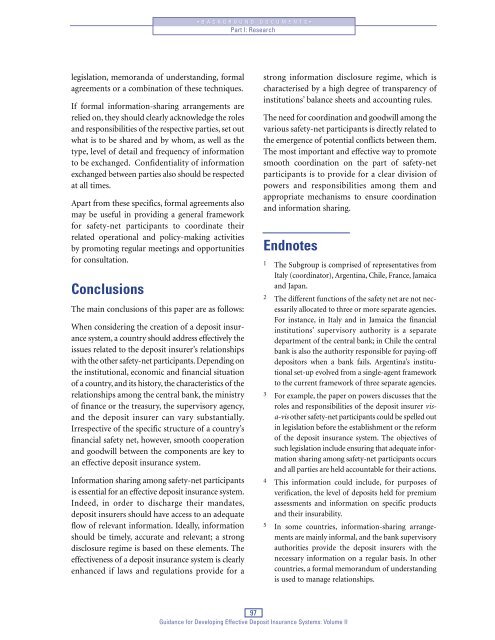Volume II - PDF - International Association of Deposit Insurers
Volume II - PDF - International Association of Deposit Insurers
Volume II - PDF - International Association of Deposit Insurers
- No tags were found...
You also want an ePaper? Increase the reach of your titles
YUMPU automatically turns print PDFs into web optimized ePapers that Google loves.
•BACKGROUND DOCUMENTS•<br />
Part I: Research<br />
legislation, memoranda <strong>of</strong> understanding, formal<br />
agreements or a combination <strong>of</strong> these techniques.<br />
If formal information-sharing arrangements are<br />
relied on, they should clearly acknowledge the roles<br />
and responsibilities <strong>of</strong> the respective parties, set out<br />
what is to be shared and by whom, as well as the<br />
type, level <strong>of</strong> detail and frequency <strong>of</strong> information<br />
to be exchanged. Confidentiality <strong>of</strong> information<br />
exchanged between parties also should be respected<br />
at all times.<br />
Apart from these specifics, formal agreements also<br />
may be useful in providing a general framework<br />
for safety-net participants to coordinate their<br />
related operational and policy-making activities<br />
by promoting regular meetings and opportunities<br />
for consultation.<br />
Conclusions<br />
The main conclusions <strong>of</strong> this paper are as follows:<br />
When considering the creation <strong>of</strong> a deposit insurance<br />
system, a country should address effectively the<br />
issues related to the deposit insurer’s relationships<br />
with the other safety-net participants. Depending on<br />
the institutional, economic and financial situation<br />
<strong>of</strong> a country, and its history, the characteristics <strong>of</strong> the<br />
relationships among the central bank, the ministry<br />
<strong>of</strong> finance or the treasury, the supervisory agency,<br />
and the deposit insurer can vary substantially.<br />
Irrespective <strong>of</strong> the specific structure <strong>of</strong> a country’s<br />
financial safety net, however, smooth cooperation<br />
and goodwill between the components are key to<br />
an effective deposit insurance system.<br />
Information sharing among safety-net participants<br />
is essential for an effective deposit insurance system.<br />
Indeed, in order to discharge their mandates,<br />
deposit insurers should have access to an adequate<br />
flow <strong>of</strong> relevant information. Ideally, information<br />
should be timely, accurate and relevant; a strong<br />
disclosure regime is based on these elements. The<br />
effectiveness <strong>of</strong> a deposit insurance system is clearly<br />
enhanced if laws and regulations provide for a<br />
strong information disclosure regime, which is<br />
characterised by a high degree <strong>of</strong> transparency <strong>of</strong><br />
institutions’ balance sheets and accounting rules.<br />
The need for coordination and goodwill among the<br />
various safety-net participants is directly related to<br />
the emergence <strong>of</strong> potential conflicts between them.<br />
The most important and effective way to promote<br />
smooth coordination on the part <strong>of</strong> safety-net<br />
participants is to provide for a clear division <strong>of</strong><br />
powers and responsibilities among them and<br />
appropriate mechanisms to ensure coordination<br />
and information sharing.<br />
Endnotes<br />
1 The Subgroup is comprised <strong>of</strong> representatives from<br />
Italy (coordinator), Argentina, Chile, France, Jamaica<br />
and Japan.<br />
2 The different functions <strong>of</strong> the safety net are not necessarily<br />
allocated to three or more separate agencies.<br />
For instance, in Italy and in Jamaica the financial<br />
institutions’ supervisory authority is a separate<br />
department <strong>of</strong> the central bank; in Chile the central<br />
bank is also the authority responsible for paying-<strong>of</strong>f<br />
depositors when a bank fails. Argentina’s institutional<br />
set-up evolved from a single-agent framework<br />
to the current framework <strong>of</strong> three separate agencies.<br />
3 For example, the paper on powers discusses that the<br />
roles and responsibilities <strong>of</strong> the deposit insurer visa-vis<br />
other safety-net participants could be spelled out<br />
in legislation before the establishment or the reform<br />
<strong>of</strong> the deposit insurance system. The objectives <strong>of</strong><br />
such legislation include ensuring that adequate information<br />
sharing among safety-net participants occurs<br />
and all parties are held accountable for their actions.<br />
4 This information could include, for purposes <strong>of</strong><br />
verification, the level <strong>of</strong> deposits held for premium<br />
assessments and information on specific products<br />
and their insurability.<br />
5 In some countries, information-sharing arrangements<br />
are mainly informal, and the bank supervisory<br />
authorities provide the deposit insurers with the<br />
necessary information on a regular basis. In other<br />
countries, a formal memorandum <strong>of</strong> understanding<br />
is used to manage relationships.<br />
97<br />
Guidance for Developing Effective <strong>Deposit</strong> Insurance Systems: <strong>Volume</strong> <strong>II</strong>
















